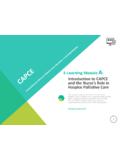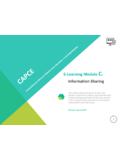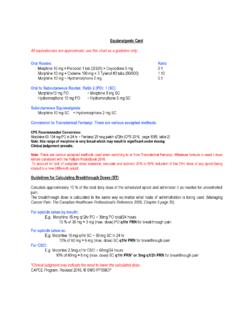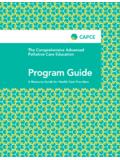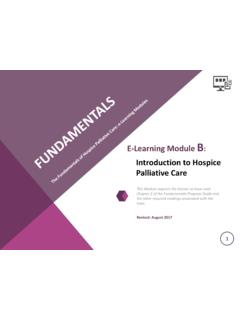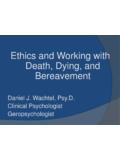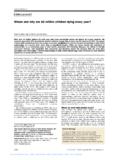Transcription of E-Learning Module Introduction to Death and Dying
1 1E-Learning Module A: Introduction to Death and DyingThis Module requires the learner to have read Chapter 1 of the Fundamentals Program Guide and the other required readings associated with the topic. Revised: August 2017 Contents of this E-Learning Module may be reproduced in whole or in part provided the intended use is for non-commercial purposes and full acknowledgement is given to the Southwestern Ontario Hospice Palliative Care Education Program and St. Joseph s Health Care reference as follows: Southwestern Ontario Hospice Palliative Care Education Program. Comprehensive Advanced Palliative Care Education E-Learning Modules. London: Southwestern Ontario Hospice Palliative Care Education Program, St. Joseph s Health Care London; 2013; second edition STARTEDThis E-Learning Module has been designed to consolidate key concepts from the required readings and provide an opportunity to begin applying these concepts through self-directed reflection and scenario-based work, in preparation for the case-based discussions, in-person, with other STARTEDIn this Module you will review the content highlights associated with Chapter 1 of your Program would be best if you have read Chapter 1 in advance and have the Program Guide, as well as the Domains of Issues Laminate with you as you complete this will be prompted to write down your thoughts or ideas during this Module .
2 You can do so in the notes section at the end of Chapter 1 in your Program Guide. These notes are just for you; you are not required to share bringing forward any questions from the E-Learning Modules to your next Peer-to-Peer Exchange or your next Case-Based Learning COVERED Emotional Responses to Dying and Death Views About Dying and Death5 EMOTIONAL RESPONSES TO Dying AND DEATHIn order to best support the person with a life-limiting illness and his or her family, it is important to confront your own feelings related to Dying and Death . Thoughts of Death can give rise to many emotions. How you feel about Death will impact how you care for other people. Think back to when you drew your own Death in the first Case-Based Learning Session and write down some of the emotions you experienced RESPONSES TO Dying AND DEATHK nowing how you feel about Death is important. Having an understanding about your own emotional reactions towards Death affects your ability to understand the scope of emotions that Dying people and their families RESPONSES TO Dying AND DEATHFEAR Why might the person and/or family be fearful?
3 8 EMOTIONAL RESPONSES TO Dying AND DEATHFEARWhy might the person and/or family be fearful? Fear of specific procedures Fear of losing control of bodily functions or cognition Fear of suffering with unmanaged symptoms Fear of being a burden to the family Fear of Dying alone Fear of the unknown9 EMOTIONAL RESPONSES TO Dying AND DEATHANXIETY Why might the person and/or family be anxious?10 EMOTIONAL RESPONSES TO Dying AND DEATHANXIETYWhy might the person and/or family be anxious? Due to disability; inability to work Due to loss of a familial role Due to financial impact Due to desire to leave a legacy Due to unknown future well-being of family Due to personal religion/spirituality Due to examining the purpose of life now11 EMOTIONAL RESPONSES TO Dying AND DEATHANGER Why might the person and/or family be angry?12 EMOTIONAL RESPONSES TO Dying AND DEATHANGERWhy might the person and/or family be angry? Feeling fearful (fear is probably the most common source of anger) Feeling deprived of relationships Feeling robbed of hopes and dreams ( the cruise, the graduation) Leaving unfinished business Experiencing delays in the health care system ( waiting for test results, waiting for appointment)13 EMOTIONAL RESPONSES TO Dying AND DEATHSADNESS, DESPAIR, AND HOPELESSNESS Why might the person/family feel sadness, despair, hopelessness?
4 14 EMOTIONAL RESPONSES TO Dying AND DEATHSADNESS, DESPAIR, AND HOPELESSNESSWhy might the person/family feel sadness, despair, hopelessness? Aware that a cure for the disease is no longer possible Experiencing unmanaged symptoms, pain not managed Realizing that life projects are not done and/or will go undone Going to miss an important event, wedding, birth Loss of relationships Aware of the totality of personal loss15 EMOTIONAL RESPONSES TO Dying AND DEATHANGUISH AND GUILT Why might the person and/or family feel anguished and guilty?16 EMOTIONAL RESPONSES TO Dying AND DEATHANGUISH AND GUILTWhy might the person and/or family feel anguished and guilty? Did not seek medical help soon enough Have regrets around life style choices Have had no connection with family for years Have persistent conflict with family and no reconciliation Feel they are abandoning the family17 EMOTIONAL RESPONSES TO Dying AND Death Compare your feelings to the possible emotional responses to Death ?
5 What do you notice? What are your reflections? Write down your observations and RESPONSES TO Dying AND Death Why is it important to consider how you feel as compared to how others might feel about Death ?How might this knowledge help you through the Fundamentals program? support to the person and family?19 EMOTIONAL RESPONSES TO Dying AND DEATHAs someone providing support to a person and family in hospice palliative care, you are called upon to see Death as a natural process. The thought of Death usually arouses a variety of anxieties and on your perceptions, beliefs and fears about Death may assist you to better understand those in your individual s reaction to Dying and Death is unique. Approach each person s response with compassion, empathy and a non-judgmental ABOUT Dying AND DEATHHow we die and how we care for people who are Dying and their families has changed over time. Understanding the generational perspectives on Death can help you understand the beliefs, values and responses to Dying and Death of the person and his or her ABOUT Dying AND Death Think back (or turn back) to Chapter 1 What are the factors that impact attitudes towards Death ?
6 Try to think of at least 3 and jot them down on ABOUT Dying AND DEATHC onsider the scenario of a family conference where the person is 45 and the family is comprised of generations that range from the person s adult child in his or her mid 20 s to the person s parents who are in their 60 s and the grandmother in her mid-90 s. Looking at the generations represented at this family conference, how will the information about generational differences assist you in your understanding of a person s decision making around issues such as treatment choices and care settings?23 VIEWS ABOUT Dying AND DEATHThe engagement of families and individuals in setting goals of care and providing the care can be complex and starts with understanding, appreciating and anticipating how their experiences may shape their approach to the IT TOGETHERAs care providers it is critical that we: Remember the importance of self-care and self-awareness Bring knowledge and skill to the bedside along with our experiences, history and beliefs Balance caring for others and caring for self Acknowledge the uniqueness of each person s attitudes, values and expectations regarding Dying and Death Understand how the historical trends in the experience of Dying and Death in western society impact decision making and care IT TOGETHER With what you know now, what might you start to anticipate as your own self care needs in the field?
7 Capture your initial thoughts on a piece of in the program, you will revisit the concept of self care in more detail; however, starting to think about it now will help you in your journey through this IT TOGETHERAs you finish Module A of your E-Learning , we (your Facilitator) would like to take another opportunity to welcome you to the Fundamentals of Hospice Palliative Care program. We are excited to have this opportunity to work with you by providing you with opportunities to gain knowledge and practice with tools and resources. 27 WHAT HAPPENS NEXTTo prepare for the next E-Learning Module , you will need to read the associated Program Guide chapter in advance. In order to complete the next E-Learning Module you will need both the Program Guide and Domains of Issues Laminate with addition, you will need a drinking straw and a clothespin or paperclip on hand when completing Module the Pallium website free on-line Module Taking Ownership )28 This E-Learning resource is the property of:The Palliative Pain & Symptom Management Consultation Program -Southwestern Ontario St.
8 Joseph s Health Care, London
